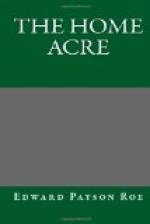Like other fruit-trees, the peach does not thrive on low, wet ground, and the fruit-buds are much more apt to be winter-killed in such localities. A light, warm soil is regarded as the most favorable.
Of course we can grow this fruit on espaliers, as they do abroad; but there are few localities where any advantage is to be derived from this course. In our latitude I much prefer cool northern exposures, for the reason that the fruitbuds are kept dormant during warm spells in winter, and so late in spring that they escape injury from frost. Alternate freezing and thawing is more harmful than steady cold. The buds are seldom safe, however, at any time when the mercury sinks ten or fifteen degrees below zero.
As we have intimated, abuse of the peach-tree has developed a fatal disease, known as the “yellows.” It manifests itself in yellow, sickly foliage, numerous and feeble sprouts along the larger limbs and trunk, and small miserable fruit, ripening prematurely. I can almost taste the yellows in much of the fruit bought in market. Some regard the disease as very contagious; others do not. It is best to be on the safe side. If a tree is affected generally, dig it out by the roots and burn it at once; if only a branch shows evidence of the malady, cut it off well back, and commit it to the flames. The only remedy is to propagate from trees in sound health and vigor.
Like the apple, the peach-tree is everywhere subject to injury from a borer, named “exitiosa, or the destructive.” The eggs from which these little pests are hatched are laid by the moth during the summer upon the stem of the tree very near the root; the grubs bore through the outer bark, and devour the inner bark and sap-wood. Fortunately they soon reveal their evil work by the castings, and by the gum which exudes from the hole by which they entered. They can not do much harm, unless a tree is neglected; in this case, however, they will soon enfeeble, and probably destroy it. When once within a tree, borers must be cut out with a sharp-pointed knife, carefully yet thoroughly. The wounds from the knife may be severe, but the ceaseless gnawing of the grub is fatal. If the tree has been lacerated to some extent, a plaster of moistened clay or cow-manure makes a good salve. Keeping the borers out of the tree is far better than taking them out; and this can be effected by wrapping the stem at the ground—two inches below the surface, and five above—with strong hardware or sheathing paper. If this is tied tightly about the tree, the moth cannot lay its eggs upon the stem. A neighbor of mine has used this protection not only on the peach, but also on the apple, with almost complete success. Of course the pests will try to find their way under it, and it would be well to take off the wrapper occasionally and examine the trees. The paper must also be renewed before it is so far decayed as to be valueless. It should be remembered also that the borer will attack the trees from the first year of life to the end.




